#interferometer
Text
FTIR Spectrometer

Fourier Transform Infrared Spectroscopy (FTIR) is a powerful analytical technique used for identifying chemical compounds and determining their molecular structure based on their interaction with infrared light. High sensitive integrated DLATGS detector.
0 notes
Text
Ass Cheek Fucking w/ Big Cumshot on Ass Cock in Ass Crack Custom Fetish
SipNPlay Show Featuring LuckyBDallas & Virgo Peridot
Angry MILF stepmother blows spying stepsons big cock
Busty Nikki licks her naughty boss pussy
Boobs popping out of her braless Top
Ebony Teen Strips and Struggles To Remove Shorts
Gay teen boys kiss Wake Up Sleepyhead
Amigo bate com a rola e goza na cara da noiva e corninho assiste tudo pelo celular
XUXA Amor estranho amor Xuxa
JAV huge orgy with busty actresses Subtitled
#hemicircular#rocked#dollskill#withdraws#manganesic#photocopying#moistening#monzodiorite#ichthyolite#homelinesses#pub.#interferometer#water-growing#subfascial#Fotinas#topog.#sinew-backed#gedd#proabsolutist#whatten
0 notes
Text

Oh I forgot to post this. LISA is a proposed gravitational wave detector whos component spacecrafts will be located 2.5 million kilometers from each other, orbiting around the sun. Pretty cool. Here's a wikipedia article about it if you are interested.
#lizart#17776#laser interferometer space antenna#lisa#gijinka#nasa#european space agency#17776 oc#spacecraft#gijinka art#my ocs#17776 football
198 notes
·
View notes
Text
Completely forgot that JUICE (JUpiter ICy moon Explorer) (space probe) has a piece of equipment called RIME
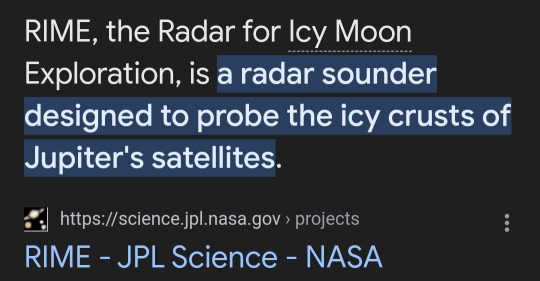
They 100% gave it that title on purpose so the acronym would be RIME btw. Because it has to do with ice. And they're all NERDS (affectionate).
Anyway Rime the Cat is REAL and in space!!!
#juice my beloved#some of the other instruments also have fun names#like PRIDE!! (Planetary Radio Interferometer and Doppler Experiment)#and two of the experiments for RPWI are called gandalf and frodo fjgjfhf#RPWI also uses sonic as its logo :]#big fan of juice if u couldn't tell. i've been keeping up with this baby for years#from its construction to its launch last year to its flybys soon!!#first flyby will be in august (there will be 3 earth flybys if i'm remembering right lol)#when it gets to jupiter in 2031 it would be my DREAM to work on the data it sends back#ough... well anyway. ramble over fjgjdhdg#vixentalks#rime the cat#<- yeah tagging this w her. that's my space probe instrument now!!
34 notes
·
View notes
Text
the motto rn is repeating "it can't possibly be that hard" as I talk myself through trying to figure out how an entire repository of code I didn't write using a library noted for being hard to deal with for something I haven't talked to anyone about in a whole month
like it's definitely that hard, why do I need to lie to myself
#physics#research#this is what I do instead of counting interferometer fringes with my rusty ass eyeballs
7 notes
·
View notes
Text
Scientists Discover Long Theorized 'Low Hum' Created by Supermassive Black Holes

Scientific theories surrounding gravitational wave background signals may provide clues about the earliest days of the universe.
An international team of astronomers has discovered a faint hum that permeates the universe and will provide them clues about supermassive black holes, colliding galaxies and possibly the Big Bang.
The North American Nanohertz Observatory for Gravitational Waves (NANOGrav) published a study on Wednesday showcasing evidence of the long theorized but never proven gravitational wave background (GWB) noise, a type of signal they believe emanates from supermassive black holes and colliding galaxies and may contain traces of the gravitational ripples caused by the Big Bang.
Four of the study’s six papers were published in the Astrophysical Journal Letters, the remaining two have been accepted for publication at a later date. The discovery was first made in 2021, but the culmination of their work is just now being published.
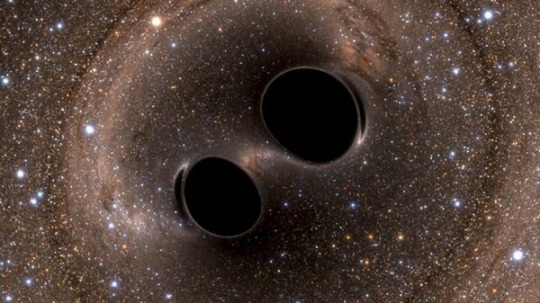
‘Humming Universe’: Hint of Gravitational Wave ‘Background’ Detected As Study Probes Cosmic Mystery! visual of gravitational waves from two converging black holes is depicted on a monitor behind Laser Interferometer Gravitational-Wave Observatory (LIGO) Co-Founder Kip Thorne as he speaks to members of the media following a news conference at the National Press Club in Washington, Thursday, Feb. 11, 2016. © AP Photo/Andrew Harnik
While GWB had been theorized before, no direct evidence had been found until now.
Gravitational waves themselves are also technically a recent discovery. While they were first described in Einstein’s 1915 Theory of General Relativity, they had not been detected until 2015.
While every piece of matter in the universe emits gravitational waves - most of them are undetectable - scientists can only hope to observe the effects of some of the largest bodies in the universe.
That finally happened when the Laser Interferometer Gravitational-wave Observatory (LIGO) detected them for the first time in 2015. The LIGO shoots lasers down three-mile-long perpendicular tubes, with the hope that a gravitational wave will pass over it, causing one laser to shrink slightly while the other grows.
Started in 1994 and first completed in 1997, the LIGO cost $395 million to build and didn’t detect any waves for the first 10 years of its existence. It shut down temporarily for a $200 million upgrade and renovation before finally detecting a gravitational wave that scientists believe came from two black holes, roughly 30 times the size of the sun each, colliding about 1.3 billion light-years from Earth.
But LIGO is not capable of detecting GWB created by super massive black holes, which range from 100,000 to six billion times the size of the sun.
So instead, the scientists at NANOGrav looked to the stars, or more specifically pulsars.
Pulsars are dead stars, also known as neutron stars, that are highly magnetic and rotate roughly 700 times a second. Their spin is incredibly consistent and looks like flickering when observed from Earth. They are sometimes compared to lighthouses or clocks because of their consistency.
The NANOGrav astronomers watched pulsars for 15 years across different observatories in West Virginia, Puerto Rico, New Mexico and Canada, waiting for tiny variations that would indicate a gravitational wave from a supermassive black hole.
They were able to distinguish the signal from other gravitational waves because of the pattern it passed through the pulsar. GWBs are unique from other gravitational waves because they come so close together they overlap. The researchers describe it by comparing it to hearing a crowd of people talking at once. At first, it sounds like a low consistent hum, until you concentrate and can pick out specific conversations.
The same became true of GWBs once astronomers were able to detect the tiniest variations. Officials say they could predict the pulses from the pulsars down to 1 microsecond, the equivalent of measuring the distance of the moon within a thousandth of a millimeter.
“We are extraordinarily excited to see this pattern pop out finally,” said Stephen Taylor, a gravitational wave astrophysicist at Vanderbilt University, who co-led the research.
While scientists aren’t positive about the source of the GWB, it mirrored theories about the types of gravitational waves thought to be created by supermassive black holes.
Scientists also say the rate of the waves is increasing, suggesting there may be hundreds or even thousands of supermassive black holes that have not yet been discovered. The signals may help us discover where some of these objects are and how they work, as well as provide scientists clues into the formation of galaxies and even the universe.
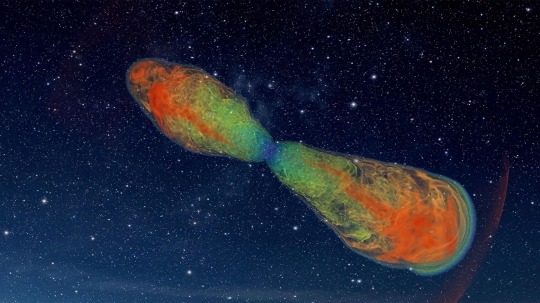
Gravitational Waves May Be Generated From Debris Fields Around Dying Stars — Study June 7, 2023!
Scientists previously feared supermassive black holes would never collide and just continually orbit each other; this was called the “final parsec problem” in the astrophysicist community.
“To get these types of high amplitudes that we are seeing, we need fairly massive black holes, and they need to form binaries [aka supermassive black holes] quite frequently and evolve quite efficiently,” Luke Zoltan Kelley, an assistant professor at the University of California, Berkeley who participated in the NANOGrav study, said in a statement.
He adds if it is confirmed that the waves came from a supermassive black hole, “then they absolutely had to have passed the final parsec one way or another.”
— Ian DeMartino, Sputnik International, Wednesday June 28, 2023
#Laser Interferometer Gravitational-Wave Observatory (LIGO)#Gravitational Waves#Science & Tech.#Puerto Rico 🇵🇷#West Virginia#Earth#Albert Einstein
2 notes
·
View notes
Text
Demystifying the Fiber Identifier: Unveiling the Secrets of Light Measurement
Specialized equipment used to measure the strength of light signals in optical fibers is known as an optical power meter. Optical power meter measures optical power quantitatively in quantities such as watts (W) or decibels (dBm), providing vital insights into the performance and health of optical networks.
Operation and components:
Optical power meters are made up of a photodetector, which transforms light into electrical signals, and a display unit, which displays the measured power. The wavelength range of the light signals to be monitored determines the photodetector, which is often a silicon or indium gallium arsenide diode.

Optical power meters can measure wavelengths ranging from visible light to infrared, encompassing the most widely used wavelengths in fiber optic communication systems. Some sophisticated versions additionally have replaceable detectors, which allow users to adapt to varied wavelength ranges.
Optical Power Meter Applications:
Installation and upkeep: Optical power meters are essential during the installation and maintenance of fiber optic networks for evaluating signal strength, assuring proper splicing and connectorization, and resolving network faults. They assist technicians in identifying power losses or abnormal power levels, allowing them to take remedial action as soon as possible. Optical light source is also of great use.
Network Monitoring: In live optical networks, continual monitoring of optical power levels is required to identify signal deterioration, fiber breakage, and other abnormalities that might influence overall network performance. Optical power meters monitor power in real-time, assisting network operators in identifying possible faults and taking proactive actions to ensure network integrity.
Choosing an Optical Power Meter:
Several considerations should be addressed while choosing an optical power meter:
Power Measurement Range: Choose a power meter that can manage a wide range of power levels, accommodating both high and low power signals seen in various fiber optic systems.
Accuracy and Resolution: To guarantee exact measurements, look for a power meter with good accuracy and resolution. The resolution of an instrument defines the lowest observable power change, whereas accuracy represents its overall dependability.
Features and connectivity: Consider the power meter's connectivity choices, such as USB, Bluetooth, or Wi-Fi, which can help with data transmission and remote control. Data logging, wavelength identification, and auto-calibration are all features that can improve usability. You can buy fiber identifier online.

Follow our Facebook and Twitter for more information about our product.
#Fiber Identifier#Optical Light Source#Optical Power Meter#Visual Fault Locator#Fiber Interferometer
2 notes
·
View notes
Note
Fizzy asked boops followers to use beep/boop pronouns. Beep had a good idea. Because askbox should not be used in vain, I should ask boop what is boops favourite experiment.
I'd say my favorite was the michelson morley experiment, which kind of kickstarted modern physics. It disproved the aether hypothesis. It woke up all the classical physicists who thought they were getting close to understanding all of physics. Nice and humbling.
#michelson morley experiment#michelson morley interferometer#physics#serious post#aether hypothesis#electromagnetism#EM waves#light#electricity#magnetism#also thanks for the pronoun test btw.#much appreciated
3 notes
·
View notes
Link
Screenshot of the Zygo white light interferometry microscope software. (Credit: Huygens Optics) Whit...
0 notes
Text
window open, nice breeze, tegan and sara cd on 🥰
lab report due 17 hours ago 💥💥💥😵☄️
#i am in Lab Report Hell#michelson. why did you have to make an interferometer#physicsblr#<perhaps that is a thing?#k
2 notes
·
View notes
Text
Top Interferometers Suppliers In India: Empowering Innovation

Modern interferometers are essential tools in Physics, and Interferometers Suppliers In India are vital to the supply of these devices. These vendors ensure the availability of top-notch tools for verifying the accuracy of optical components and measuring short distances and wavelengths. As the top Interferometers Suppliers in India, we at Indosaw are dedicated to offering the best learning resources. Join forces with us to get instruments of unmatched quality, such as interferometers, which ensure accuracy and dependability for scientific research.
#Interferometers Suppliers In India#Best Interferometers Suppliers In India#Top Interferometers Suppliers In India#Interferometers Suppliers#Best Interferometers Suppliers#Top Interferometers Suppliers
0 notes
Text
Luminiferous Aether
Introduction
The concept of the luminiferous aether (also known as “ether”) was central to the theoretical framework of physics before the advent of Einstein’s theory of relativity. Essentially, it was considered the medium through which light waves propagate, much like sound waves require a medium such as air to travel.
The Nature of Light: A Historical Perspective
To understand the…
View On WordPress
#Index#Lorentz Transformations#Luminiferous Aether#Michelson Interferometer#Michelson-Morley Experiment#Special Relativity
0 notes
Text

Laser Interferometer Market Analysis, Size to 2027
North America is expected to govern a large share of the global laser interferometer market.
0 notes
Text
12 Great Gifts from Astronomy
This is a season where our thoughts turn to others and many exchange gifts with friends and family. For astronomers, our universe is the gift that keeps on giving. We’ve learned so much about it, but every question we answer leads to new things we want to know. Stars, galaxies, planets, black holes … there are endless wonders to study.
In honor of this time of year, let’s count our way through some of our favorite gifts from astronomy.
Our first astronomical gift is … one planet Earth
So far, there is only one planet that we’ve found that has everything needed to support life as we know it — Earth. Even though we’ve discovered over 5,200 planets outside our solar system, none are quite like home. But the search continues with the help of missions like our Transiting Exoplanet Survey Satellite (TESS). And even you (yes, you!) can help in the search with citizen science programs like Planet Hunters TESS and Backyard Worlds.

Our second astronomical gift is … two giant bubbles
Astronomers found out that our Milky Way galaxy is blowing bubbles — two of them! Each bubble is about 25,000 light-years tall and glows in gamma rays. Scientists using data from our Fermi Gamma-ray Space Telescope discovered these structures in 2010, and we're still learning about them.

Our third astronomical gift is … three types of black holes
Most black holes fit into two size categories: stellar-mass goes up to hundreds of Suns, and supermassive starts at hundreds of thousands of Suns. But what happens between those two? Where are the midsize ones? With the help of NASA’s Hubble Space Telescope, scientists found the best evidence yet for that third, in between type that we call intermediate-mass black holes. The masses of these black holes should range from around a hundred to hundreds of thousands of times the Sun’s mass. The hunt continues for these elusive black holes.

Our fourth and fifth astronomical gifts are … Stephan’s Quintet
When looking at this stunning image of Stephan’s Quintet from our James Webb Space Telescope, it seems like five galaxies are hanging around one another — but did you know that one of the galaxies is much closer than the others? Four of the five galaxies are hanging out together about 290 million light-years away, but the fifth and leftmost galaxy in the image below — called NGC 7320 — is actually closer to Earth at just 40 million light-years away.

Our sixth astronomical gift is … an eclipsing six-star system
Astronomers found a six-star system where all of the stars undergo eclipses, using data from our TESS mission, a supercomputer, and automated eclipse-identifying software. The system, called TYC 7037-89-1, is located 1,900 light-years away in the constellation Eridanus and the first of its kind we’ve found.
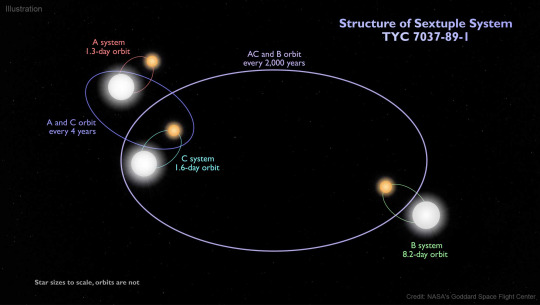
Our seventh astronomical gift is … seven Earth-sized planets
In 2017, our now-retired Spitzer Space Telescope helped find seven Earth-size planets around TRAPPIST-1. It remains the largest batch of Earth-size worlds found around a single star and the most rocky planets found in one star’s habitable zone, the range of distances where conditions may be just right to allow the presence of liquid water on a planet’s surface.
Further research has helped us understand the planets’ densities, atmospheres, and more!
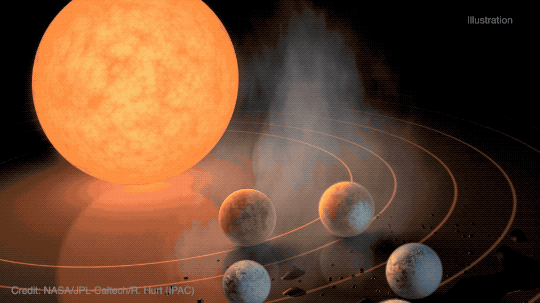
Our eighth astronomical gift is … an (almost) eight-foot mirror
The primary mirror on our Nancy Grace Roman Space Telescope is approximately eight feet in diameter, similar to our Hubble Space Telescope. But Roman can survey large regions of the sky over 1,000 times faster, allowing it to hunt for thousands of exoplanets and measure light from a billion galaxies.
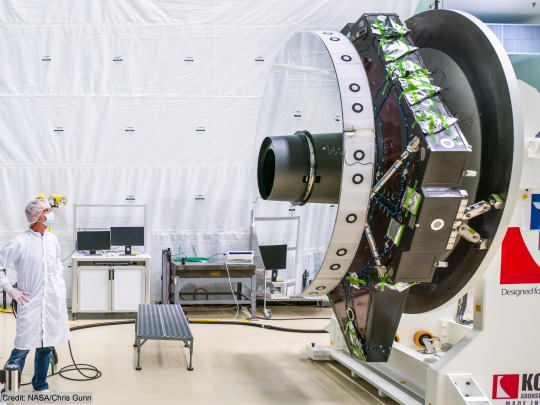
Our ninth astronomical gift is … a kilonova nine days later
In 2017, the National Science Foundation (NSF)’s Laser Interferometer Gravitational-Wave Observatory (LIGO) and European Gravitational Observatory’s Virgo detected gravitational waves from a pair of colliding neutron stars. Less than two seconds later, our telescopes detected a burst of gamma rays from the same event. It was the first time light and gravitational waves were seen from the same cosmic source. But then nine days later, astronomers saw X-ray light produced in jets in the collision’s aftermath. This later emission is called a kilonova, and it helped astronomers understand what the slower-moving material is made of.

Our tenth astronomical gift is … NuSTAR’s ten-meter-long mast
Our NuSTAR X-ray observatory is the first space telescope able to focus on high-energy X-rays. Its ten-meter-long (33 foot) mast, which deployed shortly after launch, puts NuSTAR’s detectors at the perfect distance from its reflective optics to focus X-rays. NuSTAR recently celebrated 10 years since its launch in 2012.

Our eleventh astronomical gift is … eleven days of observations
How long did our Hubble Space Telescope stare at a seemingly empty patch of sky to discover it was full of thousands of faint galaxies? More than 11 days of observations came together to capture this amazing image — that’s about 1 million seconds spread over 400 orbits around Earth!
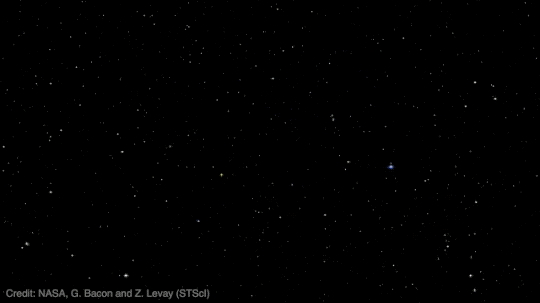
Our twelfth astronomical gift is … a twelve-kilometer radius
Pulsars are collapsed stellar cores that pack the mass of our Sun into a whirling city-sized ball, compressing matter to its limits. Our NICER telescope aboard the International Space Station helped us precisely measure one called J0030 and found it had a radius of about twelve kilometers — roughly the size of Chicago! This discovery has expanded our understanding of pulsars with the most precise and reliable size measurements of any to date.

Stay tuned to NASA Universe on Twitter and Facebook to keep up with what’s going on in the cosmos every day. You can learn more about the universe here.
Make sure to follow us on Tumblr for your regular dose of space!
#NASA#spaceblr#astronomy#space#universe#astrophysics#science#cosmos#exoplanets#black holes#stars#galaxies#gravity#hubble space telescope#james webb space telescope#international space station
1K notes
·
View notes